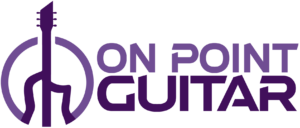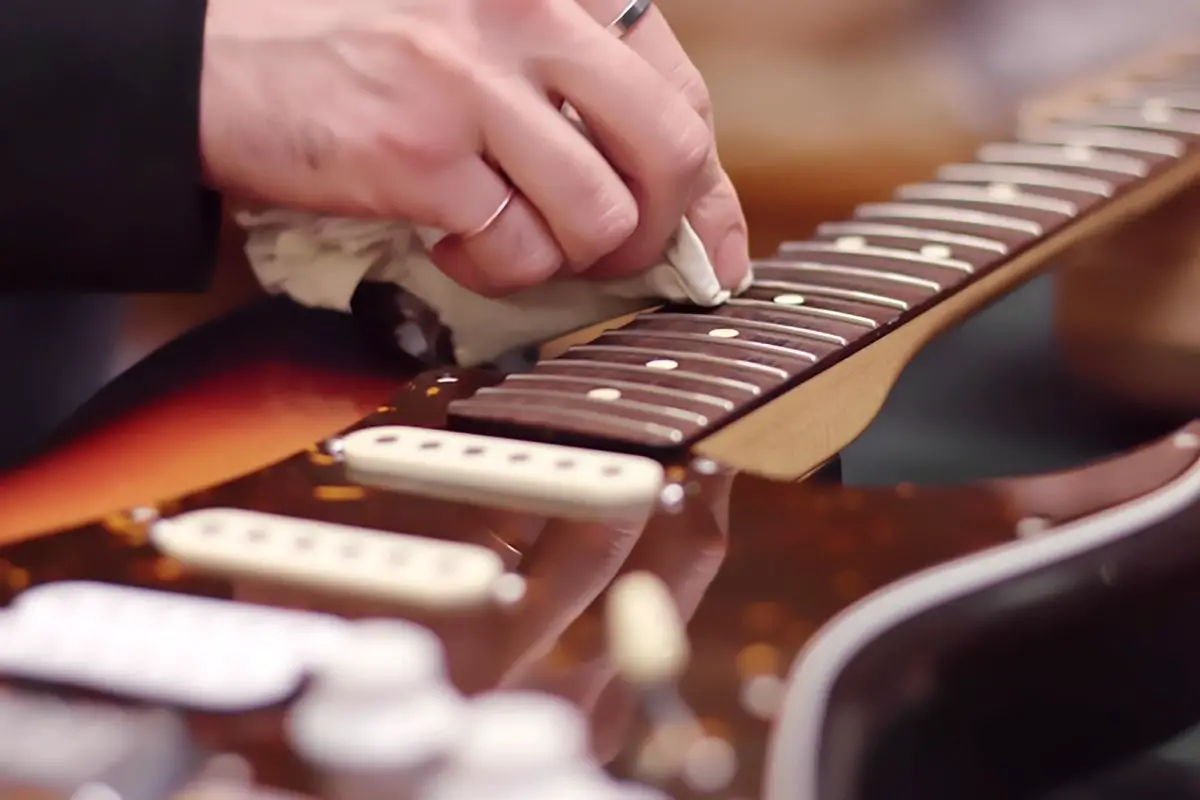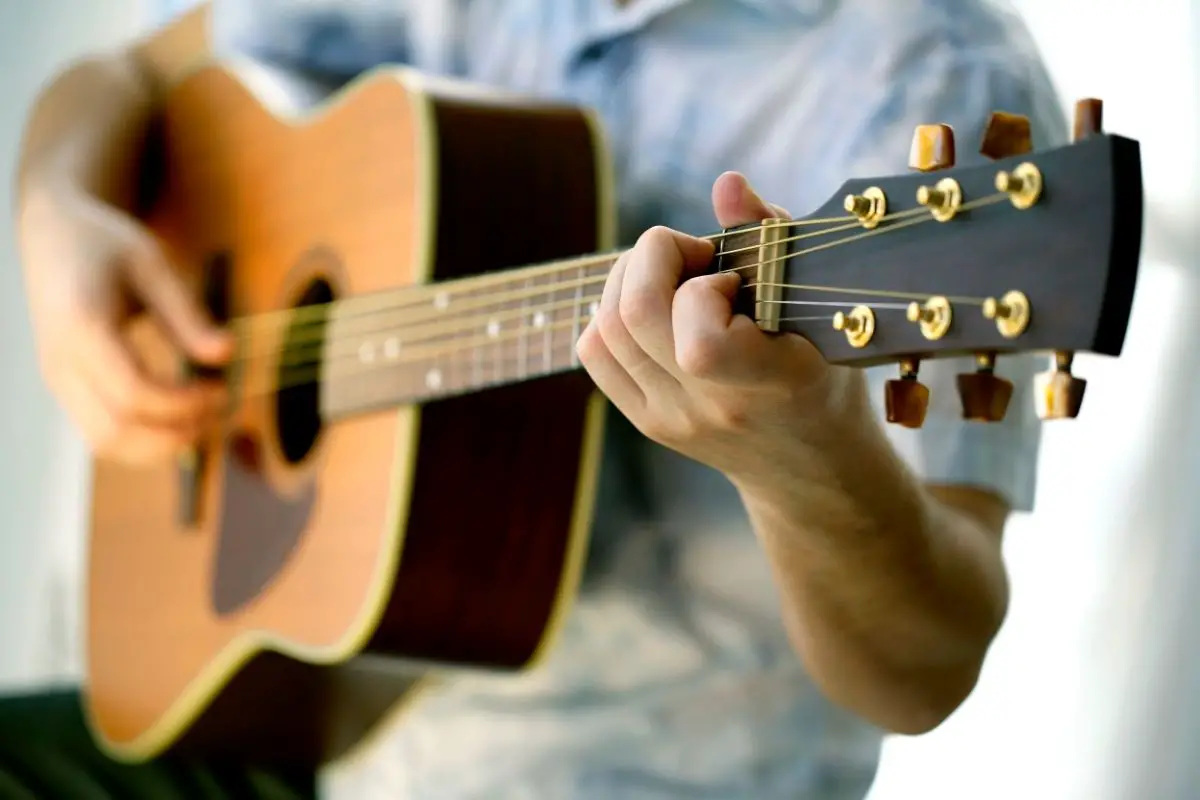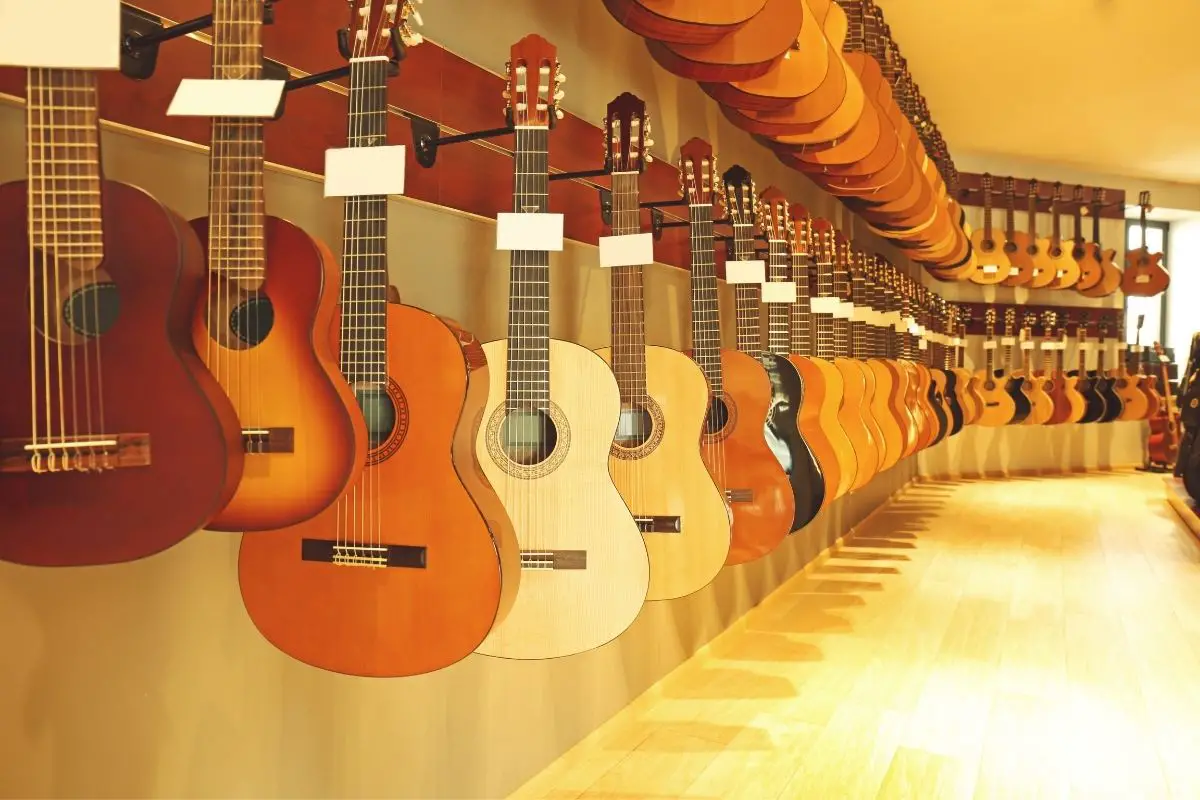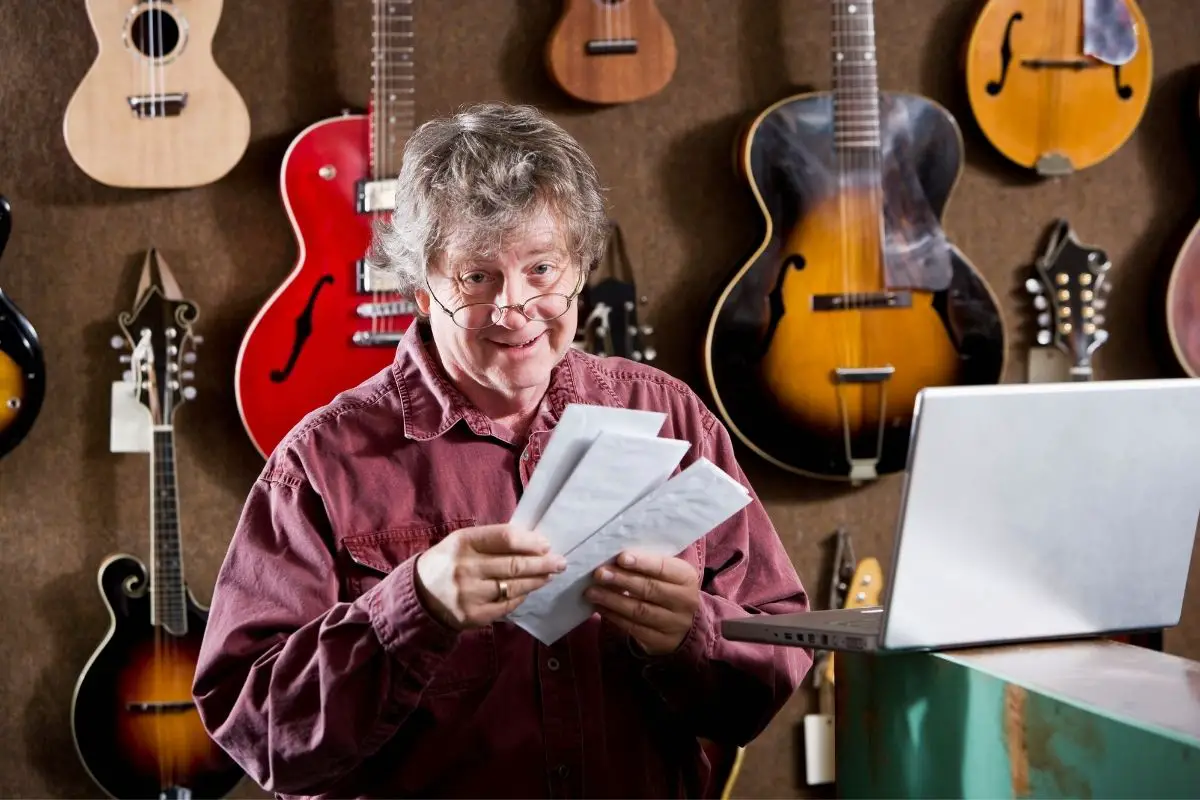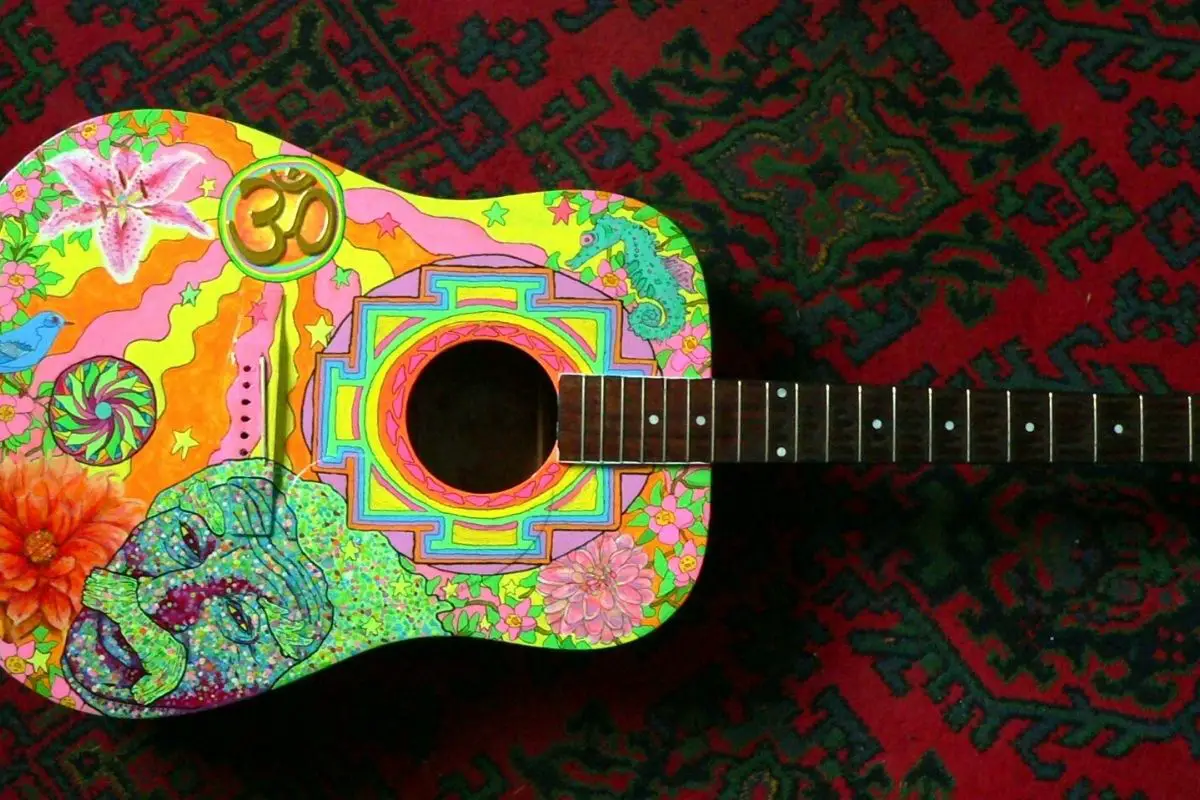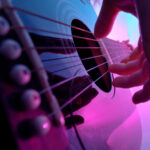When it comes to learning different types of barre chords – where you need to press multiple strings and fingers down onto the fretboard – the Bb chord is undoubtedly one of the hardest barre chords out there.
This particular chord is notoriously tricky for both expert players and beginners alike.

There’s no need to worry. We’ve put together this comprehensive guide to share our top tricks and tips with you so that you can master the Bb chord in no time at all.
We’re going to give you tips and tricks in regards to technique, too, so that you can smash out the perfect Bb barre chord. We’ll also cover some of the most common ways that people tend to go wrong when trying to play the Bb chord.
So let’s take a look at how to play a bb chord on guitar and the best ways to play a Bb chord and how you can conquer it with your own guitar!
It’s understandable why many people aren’t fans of this chord when they first start to learn the guitar. If you aren’t using the right hand shape, it can often be painful to twist your fingers to reach the right strings on the right fret.
As mentioned earlier, the bb chord is one of the hardest barre chords you’ll have to learn. But it doesn’t mean you can’t learn it in record time.
The two main things you need to learn to ace this is to learn the two shapes that matter, the A and the E shape.
Depending on the shape you settle for, your fingers will either strum on 4 strings or 6 strings.
But there’s no need to panic, we’re going to show you the easiest way to master the Bb chord so that you’ll be playing it easily in no time at all.
First, we’re going to take a look at the core hand shapes that you will need to use to play the Bb chord.
How To Play A bb Chord On Guitar
So, how do you learn how to play the bb chord on guitar? You start with the two main methods, the 1st position or 6th position. The first position uses the A shape where you place;
- The index finger on the 1st fret of the A/5th string
- The ring finger on the 3rd fret of the D/4th string
- The ring finger on the 3rd fret of the G/3rd string
- The ring finger on the 3rf fret of the B/2nd string
With the 6th position, you will use the E shape, where you strum six strings down from the low E string. Your fingers take the below positions;
- The index finger on the 6th fret of the low E/6th string
- The index finger on the 6th fret of the B/nd string
- The index finger on the 6th fret of the high E/1st string
- The middle finger on the 7th fret of the G /3rd string
- The ring finger on the 8th fret of the low A/5th string
- The pinky finger on the 8th fret of the low D/4th string
First, let’s get right into understanding these shapes!
Understanding The Core BB Chord Shapes For Guitar
The easiest ways for you to play the Bb chord on your guitar is to use either the A hand shape or the E hand shape.
We’re going to cover these core shapes in more detail down below so that you will be able to master them in no time at all, and therefore smash through that Bb chord.
Version 1: The A Shape
What makes this one of the easiest shapes to learn when it comes to applying it to the Bb chord is that there are as many as 4 different ways for you to play it.
However, rather than look at each of these as a shape in their own right, we’re going to examine them as formations of the same A shape.
Let’s take a look at the first two shape formations together.
In the first version, we place our third finger on the G string between the 2nd fret and the 3rd fret, and lean this across to the A string. You will then place your index finger on the first fret of the B string.
In the second version, we place our third finger in the same position – on the G string, resting across to the A string in the barre position. Your index finger will be placed on the B string, and you can then place your pinky finger on the high E string.
They may appear to be the same when looked at first, however, there is a noticeable difference in the fact that with the first formation, we avoid playing the high E string. However, in the second formation, playing a clean high E string is crucial.
So because the addition of the high E string makes the second formation of the A shape a little harder to play, it’s best for beginners to avoid this.
It can even make it trickier for intermediate players to master, too. This is because you will need to move your ring finger backward so that you can get the clear sound you need on the E string.
So unless that high E string is required in the piece of music that you are trying to learn, we would suggest avoiding it. The first formation will be ideal for playing the Bb chord or even for strumming it.
In order to master the barre chord using your ring finger, there are a few things that you will need to bear in mind. This is considered to be the easiest way to play the Bb chord without too much trouble.
We would suggest avoiding practicing this A shape on the first and third frets of your guitar. Instead, you will need to practice further up the fretboard, such as on the fifth and seventh frets.
You can then start to work your way back down the fretboard to the first and third frets once you have mastered the Bb chord.
Rather than use your index finger for the first note on the third fret, you will instead need to use your ring finger. This is because your ring finger will be doing most of the hard work, so you can get your weaker ring finger in place before doing this.
You will need to place your ring finger as close to your fret as you can get it, then pluck the notes in the Bb chord that you will need to hit: the D string, G string, and finally the B string. Make sure that each note is clear and easy to hear.
Once you have done this, you can then add your stronger index finger onto the A string.
Remember to take things slowly, making sure that you keep the technique in mind rather than try to rush through everything quickly. This will always be better than putting too much pressure on the strings.
So now that we’ve taken a look at the first two core shapes, let’s take a look at the next two that use the A shape. Whereas the two shapes that we have covered above are used as a barre chord, these below ones are used as individual notes.
For the third version, you will start by placing your second finger on the G string, your third finger on the D string, and your fourth finger on the A string. Your index finger will then sit on the lower B string.
For version 4, your index finger will move over to the high E string.
One thing to note about these methods is that they can be trickier than version one and version two that we have covered above. It can be easy for your chord changes to slow down when you play them using the version 3 and version 4 methods.
Depending on your hand shape, you may also find it harder to achieve the crystal clear sound that you are after when you pluck your notes.
This is especially true if you attempt to play the Bb chord further up the fretboard as the frets are much closer together here.
In order to master these positions, you will need to have precise movements for your fingers. It can be tricky to place them in adjacent positions like this.
You are of course welcome to give these two methods a try to see if they work for you. However, we would suggest using the first two versions, as these will be much easier to play and definitely more comfortable for you as a guitarist.
Even though they will need more practice to master, they will be easier to switch between other chords than the third and fourth versions.
Version 2: The E Shape

So now that we’ve covered the A shape, let’s take a look at the E shape. This barre chord version of the Bb chord utilizes the high E string as well as the B string. You will need to ensure that you get a clean and clear sound from both.
There is also one version where we will use our index finger on these strings to mute them.
In version one, we will have our ring finger placed on the B string, our fourth finger placed on the G string, our second finger stretched down to the D string, and our index finger moving between the bottom E string and the high E string.
In version two, we will have our ring finger placed on the B string, our fourth finger placed on the G string, our second finger stretched down to the D string, and our index finger on the bottom E string.
If you prefer to strum your Bb chord, then we would recommend trying the second version. This is because it can give you the bass sound that you need to round out the chord, and you can avoid using a barre chord.
All you will need to do is fret out the 4 notes as we have described above, making sure that they produce a clean, clear sound. You can then allow your index finger to rest along the strings so that it touches both the high E string and the B string.
Even though it may appear that you’re making use of a barring formation, you aren’t. This helps you to mute the strings as needed.
Remember that this isn’t an easy skill to master, however, once you have, it will come in handy more than once. Especially if you are making use of quick changes in the piece that you are trying to play!
Top Tips For Playing The BB Chord
The above core hand shapes give you the basics of how to play the Bb chord easily. So now we’re going to cover different types of Bb chord so that you can find the best way to play it on your particular guitar and for your particular playing style.
Mastering The Bb Power Chord
If you’re into your rock music, then you will of course want to master the Bb power chord. Interestingly, the power chord can be used as an alternative to a barred Bb chord if needed at any point.
This is because it is basically a barre chord in itself, but with a few notes missing.
Note that it won’t sound as well rounded as a barre chord, but it will certainly get the job done in a pinch. Place your third finger on the G string, fourth finger on the D string, and your index finger on the B string.
Mastering The BB Power Cord With An Additional 3rd Note
Want to add a lighter tone to the Bb power chord that we have covered above? Then adding an additional third note to the mix can get the sound that you are after. This is a particularly good choice if you prefer to play acoustic rather than an electric guitar.
It’s worth noting that this formation is very similar to the A shape that we covered in more detail above. However, you won’t need to cram your fingers into such a short space.
This features placing your third finger on the G string, your fourth finger on the A string, and your index finger on the B string.
Mastering The Jangly Triad

Is the Bb power chord with an added third note not light enough for you? Then mastering the jangly triad will be just the thing that you need to do.
This is the ideal variation of the Bb chord to opt for if you’re playing in a band as an accompaniment to the lead guitarist. You can simply pick the notes as and when you need to.
To play the jangly triad, you will need to place your third finger on the D string on the third fret, your fourth finger on the A string on the same fret, and then your index finger on the high E string on the first fret.
Making Use Of Inversions
If you enjoy playing your guitar as part of a band, then inversions will be incredibly useful for you in terms of playing.
You can invert the Bb chord that you are trying to play, which basically means highlighting another note as the lowest note in the chord other than the root B♭ note.
So if you were to use the D or F notes in the Bb chord and make one of these the lowest note instead of the Bb, this would be an inversion.
This is a great way to play something different while keeping everything in the right key, or making sure all the harmonies fit together.
One way to invert your Bb chord is to place your third finger on the B string on the fourth fret, and then have your index finger in a barre position across the G string and the A string on the second fret.
A second way that you can invert the Bb chord is to place your fourth finger on the A string at the fifth fret, your second finger on the D string at the fourth fret, and your third finger on the high E string at the fourth fret.
A third way that you can invert the Bb chord is to place your index finger on the D string on the second fret, your second finger on the A string on the third fret, your third finger on the G string on the fourth fret, and your fourth finger on the high E string on the fifth fret.
Avoid These Methods For Learning The BB Chord
So now that we have discussed the best methods for playing the Bb chord, it’s time to take a look at some of the ways that we should avoid playing it.
This will be mostly down to how difficult it is to hold the certain barre chord position, or just because it makes the process of playing a Bb chord much harder than it needs to be.
First up is the method where you place your index finger on the high E string at the first fret, your second finger on the G string at the third fret, your third finger on the same fret on the D string, and your fourth finger on the same fret again but on the A string.
This is an incredibly difficult position for you to hold on the A shape. It puts a lot of tension in your hand when you’re trying to play this. We would suggest going for the alternative A shape that we have discussed in more detail above.
Second is the method of placing your index finger in a barre position across the A and high E string on the second fret, your second finger on the D string at the third fret, your third finger on the B string at the fourth fret, and your fourth finger on the same fret but on the G string.
This method is actually an incredibly awkward E shape that will therefore make it more difficult to play. Depending on the piece of music that you are trying to play, the high E string won’t really be needed.
We’d suggest opting for one of the alternative E shapes that we covered in more detail above.
Third is the method of placing your index finger in the barre position across the G string and the A string along the second fret, your second finger on the B string on the fourth fret, and then your third and fourth fingers on the fifth fret, but on the bottom E string and the high E string respectively.
You may think that this is simpler because it follows a G shape. However, this is much trickier than it looks. It’s actually much better to choose one of the inversions that we have covered in more detail above.
Fourth is the method of placing your index finger in the barre position across the second fret of the D string and the high E string, your second finger on the third fret of the A string, your third finger on the fourth fret on the G string, and your fourth finger on the fifth fret of the B string.
You may recognize this as a C major chord shape. However, it is a fairly awkward placement. We would suggest avoiding this and opt for either the A shape or the E shape formations that we have discussed in more detail above.
And the last method, the fifth method, is to place your index finger on the G string on the second fret.
You will then place your second finger on the fourth fret on the D string, your third finger on the same fret on the high E string, and your fourth finger on the fifth fret on the A string.
As you can see, this is a classic D chord formation. This makes it one of the harder ways to play a Bb chord. We would suggest opting for the A shape or the E shape formations that we have covered in more detail above.
How To Use The BB Chord: Everything You Need To Know

So now that we have covered the Bb chord in extensive detail, it’s time to think a little bit more about where we will be using this chord. What kind of songs can you expect to find a Bb chord in? What music styles tend to feature this chord?
After all, it can be hard to see why you should learn how to play the notoriously difficult Bb chord if you won’t need to use it in your preferred musical genre.
While it’s true that very rarely is a song ever written in the key of Bb, there are plenty of songs and musical styles that actually make use of the Bb chord. One particular key that uses the Bb chord is of course C major.
This may seem a little strange. After all, Bb isn’t one of the chords that you would associate with the key of C major, right? Some of the most common chords used in the C major key are C, Dm, Em, F, G, Am, and B diminished.
The vast majority of these chords are of course fairly standard, apart from the B diminished.
However, this B diminished chord is incredibly difficult to play, and even more difficult to play well. Because of this, some songwriters or guitarists will often flatten it, which then brings it down a fret to the Bb chord.
So this means even though the key signature is in C major, you are still likely to see some Bb chords in songs written in this key.
Some of the other popular keys where you will also encounter the Bb chord is in D major, F major, and G major. All of these key signatures and C major tend to include the Bb chord to make things more harmonically interesting.
In Summary
So there you have it! You now know everything there is to know about how to play a bb chord on guitar. We would suggest either using the A shape or E shape formations that we have covered in more detail above to make things much easier for you.
There are also several different formations to choose from so that you can find the best version for your needs.
The great thing about the Bb chord is that you can also use things like the power chord, the power chord with an additional third note, and the jangly triad to help you find the best playing style for your guitar.
You can also make use of inversions if you play in a band to get the harmonies that you are after.
We have also covered the commonly taught Bb chords that we would advise against using. These are much harder for a beginner and intermediate guitarist to play.
Instead, opt for the great A shape and E shape formations that we have covered in more detail above!
If you enjoyed this article, you might enjoy our post on ‘Learn C And C Chord Finger Position‘.

My name is Howard Matthews and I have been playing the guitar since I was knee-high. My parents like to joke that I was pulling the strings even before I was born. In fact, one of my earliest memories is sitting on the couch with my dad’s guitar, wreaking havoc on the chords.
Now, 40 years later, I can attest that I play them much better than I did back then. I have followed in the footsteps of both my parents – much to their delight – and have been the main guitarist in my band for the best part of three decades.
Music has always been my passion, and until recently my life has been so consumed with it that I haven’t had a moment to have a breath (and I wouldn’t have it any other way)!
